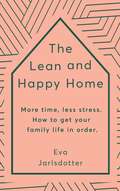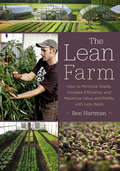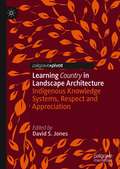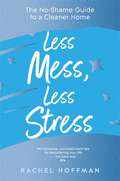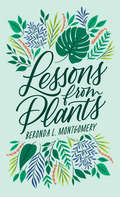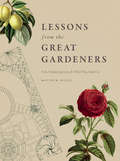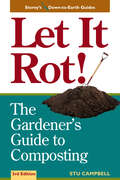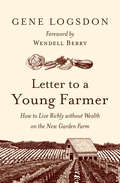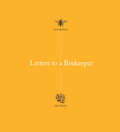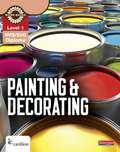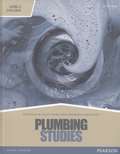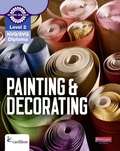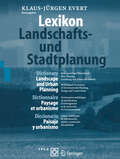- Table View
- List View
Leadership in Planning: How to Communicate Ideas and Effect Positive Change
by Jeff LevineBeing an effective city planner means being an effective leader. You need to be prepared to convince people that good planning matters. Often a well-written, thoughtful and inclusive plan doesn’t result in meaningful action, because planners don’t show leadership skills. At some point, some city planners become cynical and worn down, wondering why no one listens to them but not doing the self-reflection about how that could change. Leadership in Planning explains how to get support for planning initiatives so they don’t just fade from memory. It will guide city planners to think less about organizational charts and more about: · being a respected voice within your organization, both with staff and with your boss; · being a good communicator with people outside your organization; and · being able to understand how and when to push for good planning ideas to turn them into actions. Along the way, case studies bring these concepts to the real world of municipal planning. In addition, past planning figures’ actions are explored to see what they did right and what mistakes they made.
The Lean and Happy Home: More time, less stress. How to get your family life in order
by Eva JarlsdotterIn seven simple steps...Lean removes waste: wasted money, energy, resources.Lean will give you the gift of time.Lean is a set of principles embraced by the most creative and dynamic organisations around the world, and now for the first time, Swedish social entrepreneur Eva Jarlsdotter applies them to family life.Embracing the Japanese 'stream' technique, Eva's seven steps show you how to systematically create and maintain order. From kaizen (continuous improvement) to kanban (visual planning), these principles will bring harmony and a sense of flow to your home. No more time wasted searching for your keys, important paperwork or your internet banking password; no more throwing away food past its sell-by date or arguing about the mess; no more feeling on the back foot all the time. This transformative book will also empower children in the household to take responsibility for their belongings and their schedules, meaning a lot less parental nagging. This modern guide will transform family life from the inside out. The time you save can be channelled into doing things you actually want to do. Be inspired by Eva's own story, understand how Lean works and start to apply her small changes to your everyday life - you will be delighted with the results.
The Lean Farm: How to Minimize Waste, Increase Efficiency, and Maximize Value and Profits with Less Work
by Ben HartmanA practical, systems-based approach for a more sustainable farming operation To many people today, using the words “factory” and “farm” in the same sentence is nothing short of sacrilege. In many cases, though, the same sound business practices apply whether you are producing cars or carrots. Author Ben Hartman and other young farmers are increasingly finding that incorporating the best new ideas from business into their farming can drastically cut their wastes and increase their profits, making their farms more environmentally and economically sustainable. By explaining the lean system for identifying and eliminating waste and introducing efficiency in every aspect of the farm operation, The Lean Farm makes the case that small-scale farming can be an attractive career option for young people who are interested in growing food for their community. Working smarter, not harder, also prevents the kind of burnout that start-up farmers often encounter in the face of long, hard, backbreaking labor. Lean principles grew out of the Japanese automotive industry, but they are now being followed on progressive farms around the world. Using examples from his own family’s one-acre community-supported farm in Indiana, Hartman clearly instructs other small farmers in how to incorporate lean practices in each step of their production chain, from starting a farm and harvesting crops to training employees and selling goods. While the intended audience for this book is small-scale farmers who are part of the growing local food movement, Hartman’s prescriptions for high-value, low-cost production apply to farms and businesses of almost any size or scale that hope to harness the power of lean in their production processes.
Learn to Timber Frame: Craftsmanship, Simplicity, Timeless Beauty
by Will BeemerThe elegant simplicity of timber frame construction is made accessible to all levels of builders with step-by-step building instructions for one small, easy-to-build timber frame cabin, along with plans for modifying it to suit particular needs and locations.
Learning Country in Landscape Architecture: Indigenous Knowledge Systems, Respect and Appreciation
by David S. JonesThis book strategically focuses upon the feasibility of positioning Indigenous Knowledge Systems into tertiary built environment education and research in Australia. Australian tertiary education has little engaged with Indigenous peoples and their Indigenous Knowledge Systems, and the respectful translation of their Indigenous Knowledge Systems into tertiary education learning. In contrast, while there has been a dearth of discussion and research on this topic pertaining to the tertiary sector, the secondary school sector has passionately pursued this topic. There is an uneasiness by the tertiary sector to engage in this realm, overwhelmed already by the imperatives of the Commonwealth’s ‘Closing the Gap’ initiative to advance Aboriginal and Torres Strait Islander tertiary education successes and appointments of Indigenous academics. As a consequence, the teaching of Indigenous Knowledge Systems relevant to professional disciplines, particularly landscape architecture where it is most apt, is overlooked and similarly little addressed in the relevant professional institute education accreditation standards.
Learning from Arnstein's Ladder: From Citizen Participation to Public Engagement
by Mickey Lauria Carissa Schively SlotterbackSherry Arnstein, writing in 1969 about citizen involvement in planning processes in the United States, described a “ladder of citizen participation” that showed participation ranging from low to high. Arnstein depicted the failings of typical participation processes at the time and characterized aspirations toward engagement that have now been elevated to core values in planning practice. But since that time, the political, economic, and social context has evolved greatly, and planners, organizers, and residents have been involved in planning and community development practice in ways previously unforeseen. Learning from Arnstein’s Ladder draws on contemporary theory, expertise, empirical analysis, and practical applications in what is now more commonly termed public engagement in planning to examine the enduring impacts of Arnstein’s work and the pervasive challenges that planners face in advancing meaningful public engagement. This book presents research from throughout the world, including Australia, Brazil, India, Indonesia, Portugal, Serbia, and the United States, among others, that utilizes, critiques, revises, and expands upon Arnstein’s aspirational vision. It is essential reading for educators and students of planning.
Learning from Arnstein's Ladder: From Citizen Participation to Public Engagement
by Mickey Lauria and Carissa Schively SlotterbackSherry Arnstein, writing in 1969 about citizen involvement in planning processes in the United States, described a “ladder of citizen participation” that showed participation ranging from low to high. Arnstein depicted the failings of typical participation processes at the time and characterized aspirations toward engagement that have now been elevated to core values in planning practice. But since that time, the political, economic, and social context has evolved greatly, and planners, organizers, and residents have been involved in planning and community development practice in ways previously unforeseen. Learning from Arnstein’s Ladder draws on contemporary theory, expertise, empirical analysis, and practical applications in what is now more commonly termed public engagement in planning to examine the enduring impacts of Arnstein’s work and the pervasive challenges that planners face in advancing meaningful public engagement. This book presents research from throughout the world, including Australia, Brazil, India, Indonesia, Portugal, Serbia, and the United States, among others, that utilizes, critiques, revises, and expands upon Arnstein’s aspirational vision. It is essential reading for educators and students of planning.
Learning from the Japanese City: Looking East in Urban Design (Planning, History and Environment Series)
by Barrie SheltonJapanese cities are amongst the most intriguing and confounding anywhere. Their structures, patterns of building and broader visual characteristics defy conventional urban design theories, and the book explores why this is so. Like its cities, Japan’s written language is recognized as one of the most complicated, and the book is unique in revealing how the two are closely related. Set perceptively against a sweep of ideas drawn from history, geography, science, cultural and design theory, Learning from the Japanese City is a highly original exploration of contemporary urbanism that crosses disciplines, scales, time and space. This is a thoroughly revised and much extended version of a book that drew extensive praise in its first edition. Most parts have stood the test of time and remain. A few are replaced or removed; about a hundred figures appear for the first time. Most important is an entirely new (sixth) section. This brings together many of the urban characteristics, otherwise encountered in fragments through the book, in one walkable district of what is arguably Japan’s most convenient metropolis, Nagoya. The interplay between culture, built form and cities remains at the heart of this highly readable book, while a change in subtitle to Looking East in Urban Design reflects increased emphasis on real places and design implications.
Learning from the Japanese City: Looking East in Urban Design (Planning, History and Environment Series)
by Barrie SheltonJapanese cities are amongst the most intriguing and confounding anywhere. Their structures, patterns of building and broader visual characteristics defy conventional urban design theories, and the book explores why this is so. Like its cities, Japan’s written language is recognized as one of the most complicated, and the book is unique in revealing how the two are closely related. Set perceptively against a sweep of ideas drawn from history, geography, science, cultural and design theory, Learning from the Japanese City is a highly original exploration of contemporary urbanism that crosses disciplines, scales, time and space. This is a thoroughly revised and much extended version of a book that drew extensive praise in its first edition. Most parts have stood the test of time and remain. A few are replaced or removed; about a hundred figures appear for the first time. Most important is an entirely new (sixth) section. This brings together many of the urban characteristics, otherwise encountered in fragments through the book, in one walkable district of what is arguably Japan’s most convenient metropolis, Nagoya. The interplay between culture, built form and cities remains at the heart of this highly readable book, while a change in subtitle to Looking East in Urban Design reflects increased emphasis on real places and design implications.
Leo's Guide to Not Becoming a Statistic: How to Prevent Crime & What to Do in a Situation
by Leo PrinslooIf this book saves just one person’s life, Leo Prinsloo will be happy.Leo became a worldwide internet sensation after footage of his reaction to an attempted high-value goods-in-transit heist went viral. Stunned by his cool attitude and focused action in a crisis situation, South Africans had an example of what can happen when good people take a stand.With decades of experience in security – first as a policeman, then in the South African Police Service’s Special Task Force, and now providing arms handling and security training in the private sector – Leo has a wealth of knowledge on how to manage life-threatening incidents.Driven by a desire to empower South Africans and help them claim back their sense of safety, he offers advice for dealing with every risky situation, from how to handle hijackings and road rage, to how to keep your children safe, to the best way to secure your home and business. He also provides comprehensive information about handling firearms and basic first aid.Leo’s Guide to Not Becoming a Statistic is a guide to living your safest life in South Africa – something which has become increasingly important as our crime statistics continue to rise. Straight-talking and honest – much like Leo himself – it is an easy to use manual that makes keeping safe accessible, with relatable information and easy to implement tips.Leo says that taking the first step towards securing your safety is the most important, and his book will help you take that step.
The Less Is More Garden: Big Ideas for Designing Your Small Yard
by Susan MorrisonWith practical tips and high-end design ideas, The Less is More Garden can help you turn your small backyard into a unique space that is lovely to look at, family-friendly, and low maintenance.
Less Mess, Less Stress: The No-Shame Guide to a Cleaner Home
by Rachel HoffmanLooking for a cleaner home without the upkeep taking over your whole life?Those of us living in the real world know that it can be challenging to keep a clean and tidy home. Busy lifestyles, shared housing, physical limitations or mental health issues can all contribute to making a once calm environment feel daunting and stressful.The Unf*ck Your Habitat® system in Less Mess, Less Stress works with you, not against you, and shows how just thirty minutes (including a ten minute break!) can transform any space. With low-effort, high-reward tricks, tips, lists and challenges, this reassuring guide is full of no-nonsense advice and practical help on things you can do today for a less messy tomorrow.While this book won’t wash your dishes or fold your laundry, it will give you all the tools you’ll need to stay on top because everyone deserves – and can have – a home with less mess and less stress.Previously published as Unf*ck Your Habitat: You're Better than Your Mess
Lessons from Plants
by Beronda L. MontgomeryAn exploration of how plant behavior and adaptation offer valuable insights for human thriving. We know that plants are important. They maintain the atmosphere by absorbing carbon dioxide and producing oxygen. They nourish other living organisms and supply psychological benefits to humans as well, improving our moods and beautifying the landscape around us. But plants don’t just passively provide. They also take action. Beronda L. Montgomery explores the vigorous, creative lives of organisms often treated as static and predictable. In fact, plants are masters of adaptation. They “know” what or who they are, and they use this knowledge to make a way in the world. Plants experience a kind of sensation that does not require eyes or ears. They distinguish kin, friend, and foe, and they are able to respond to ecological competition despite lacking the capacity of fight-or-flight. Plants are even capable of transformative behaviors that allow them to maximize their chances of survival in a dynamic and sometimes unfriendly environment. Lessons from Plants enters into the depth of botanic experience and shows how we might improve human society by better appreciating not just what plants give us but also how they achieve their own purposes. What would it mean to learn from these organisms, to become more aware of our environments and to adapt to our own worlds by calling on perception and awareness rather than reason? Montgomery’s meditative study puts before us a question with the power to reframe the way we live: What would a plant do?
Lessons from the Great Gardeners: Forty Gardening Icons and What They Teach Us
by Matthew BiggsLike heirloom seeds and grafts from trees, advice from great gardeners handed down through the centuries has shaped the science and art of gardens across the globe. Spanning gardeners from fifteenth-century Japan to the contemporary United States, Lessons from the Great Gardeners profiles forty groundbreaking botanists, nurserymen, and tillers of earth, men and women whose passion, innovation, and green thumbs endure in the formal landscapes and vegetable patches of today. Entries for each gardening great highlight their iconic plants and garden designs, revealing both the gardeners’ own influences and the seeds—sometimes literal—that they sowed for gardens yet to sprout. From André Le Nôtre in seventeenth-century France, who drew on his training as an architect and hydraulic engineer to bring the topiary form to Vaux-le-Vicomte and Versailles, to the work of High Line and Lurie Garden designer Piet Oudolf, and Thomas Jefferson’s advice on creating protected garden microclimates for help growing early crops and tender fruit like figs (with peas, a Jefferson favorite), Lessons from the Great Gardeners is a resource as rich as the soil from which it springs. Featuring lush illustrations harvested from the archives of the Royal Horticultural Society, as well as sections on a dozen international gardens that showcase the lessons of the greats, this homage to the love of good, clean dirt is sure to inspire readers to get out in the sun and dig.
Lessons from the Great Gardeners: Forty Gardening Icons and What They Teach Us
by Matthew BiggsLike heirloom seeds and grafts from trees, advice from great gardeners handed down through the centuries has shaped the science and art of gardens across the globe. Spanning gardeners from fifteenth-century Japan to the contemporary United States, Lessons from the Great Gardeners profiles forty groundbreaking botanists, nurserymen, and tillers of earth, men and women whose passion, innovation, and green thumbs endure in the formal landscapes and vegetable patches of today. Entries for each gardening great highlight their iconic plants and garden designs, revealing both the gardeners’ own influences and the seeds—sometimes literal—that they sowed for gardens yet to sprout. From André Le Nôtre in seventeenth-century France, who drew on his training as an architect and hydraulic engineer to bring the topiary form to Vaux-le-Vicomte and Versailles, to the work of High Line and Lurie Garden designer Piet Oudolf, and Thomas Jefferson’s advice on creating protected garden microclimates for help growing early crops and tender fruit like figs (with peas, a Jefferson favorite), Lessons from the Great Gardeners is a resource as rich as the soil from which it springs. Featuring lush illustrations harvested from the archives of the Royal Horticultural Society, as well as sections on a dozen international gardens that showcase the lessons of the greats, this homage to the love of good, clean dirt is sure to inspire readers to get out in the sun and dig.
Lessons in Drawing Plans and Interiors: - with STUDIO
by Patricia Potwin Ellis"Focuses on taking students through each drawing they would have to do in a set of construction documents. Easy to understand for first time drafters." - Azizi Arrington-Bey, Indiana State University, USLearn step-by-step how to hand draft and draw perspectives for interiors. After learning the basics-such as lettering, scales, and types of lines-this book guides you through two-color, illustrated lessons for five hand drafting projects and eight hand-drawn interiors. You'll learn to draft and draw both residential and commercial spaces, preparing you for your career.PLEASE NOTE: Purchasing or renting this ISBN does not include access to the STUDIO resources that accompany this text. To receive free access to the STUDIO content with new copies of this book, please refer to the book + STUDIO access card bundle ISBN 9781501321726.
Let it Rot!: The Gardener's Guide to Composting (Third Edition)
by Stu CampbellStu Campbell provides an in-depth explanation of how composting works and offers clear instructions for a variety of both traditional and modern methods for successfully creating your own compost.
Let's Go Camping! From cabins to caravans, crochet your own camping Scenes: Crochet Your Own Adventure
by Kate BruningGo glamping without the threat of unpredictable weather and nasty creepy crawlies, and instead crochet your own adorable camping scene that will keep any child entertained for hours and celebrate all that is great about camping. Reminiscent of vintage camping memorabilia, you can create a nostalgic collection of crochet projects encompassing all aspects of outdoor life. With mix and match projects ranging from vintage caravans and ice cream trucks, to tents and teepees with all the camping paraphernalia of sleeping bags, backpacks and a log fire, as well as mountain and forest scenery you can create your own outdoor world. Or why not craft an alternative camping scene with a classic narrow boat, or a wooden lakeside cabin which can open up to reveal immaculately decorated insides. Instructions for playmats will give children a fantastic base for playing, allowing them to create games and stimulate their own imagination.
Letter to a Young Farmer: How to Live Richly without Wealth on the New Garden Farm
by Gene Logsdon Wendell BerryFor more than four decades, the self-described “contrary farmer” and writer Gene Logsdon has commented on the state of American agriculture. In Letter to a Young Farmer, his final book of essays, Logsdon addresses the next generation—young people who are moving back to the land to enjoy a better way of life as small-scale “garden farmers.” It’s a lifestyle that isn’t defined by accumulating wealth or by the “get big or get out” agribusiness mindset. Instead, it’s one that recognizes the beauty of nature, cherishes the land, respects our fellow creatures, and values rural traditions. It’s one that also looks forward and embraces “right technologies,” including new and innovative ways of working smarter, not harder, and avoiding premature burnout. Completed only a few weeks before the author’s death, Letter to a Young Farmer is a remarkable testament to the life and wisdom of one of the greatest rural philosophers and writers of our time. Gene’s earthy wit and sometimes irreverent humor combines with his valuable perspectives on many wide-ranging subjects—everything from how to show a ram who’s boss to enjoying the almost churchlike calmness of a well-built livestock barn. Reading this book is like sitting down on the porch with a neighbor who has learned the ways of farming through years of long observation and practice. Someone, in short, who has “seen it all” and has much to say, and much to teach us, if we only take the time to listen and learn. And Gene Logsdon was the best kind of teacher: equal parts storyteller, idealist, and rabble-rouser. His vision of a nation filled with garden farmers, based in cities, towns, and countrysides, will resonate with many people, both young and old, who long to create a more sustainable, meaningful life for themselves and a better world for all of us.
Letters to a Beekeeper
by Alys Fowler Steve BenbowThis the story of how, over the course of a year, Alys, the Guardian gardening writer, learns how to keep bees; and Steve, the urban beekeeper, learns how to plant a pollinator-friendly garden.Part beautifully designed coffee-table book, part manifesto, this collection of engaging letters, emails, texts, recipes, notes and glorious photos creates a record of the trials, tribulations, rewards and joys of working with, rather than against, nature. And along the way, you will pick up a wealth of advice, tips and ideas for growing food and keeping pollinators well fed. Letters to a Beekeeper is for lazy gardeners, novice beekeepers and everyone in between. It is the best rule-breaking, wildlife-friendly, guerilla, urban gardening, insect-identifying, honey-tasting, wax-dripping, epistolary how-to book you could ever hope to own.
Level 1 NVQ/SVQ Diploma Painting and Decorating (PDF)
by Kevin Jarvis Steve OlsenHeinemann's learner-focused painting and decorating resources are now available for the Level 1 NVQ/SVQ Diploma This tailor-made textbook for the Level 1 learner covers all the content from the Diploma specification and making sure candidates get the right tools for the job.
Level 2 Diploma in Plumbing Studies Candidate Handbook (PDF)
by Stephen Blair Phillip Davies Terry Grimwood Andy JeffreyWritten by experienced tutors in line with the level 2 specification to help prepare learners for progression into an Apprenticeship and employment. Professional case studies focus on employability skills and help learners develop the soft skills to aid job hunting and performance in the workplace. The content is logically designed and highly visual which makes plumbing principles easier to digest, understand and remember.
Level 2 NVQ/SVQ Diploma Painting and Decorating (PDF)
by Kevin Jarvis Steve OlsenThis handbook provides all the knowledge needed to achieve a diploma, with clear straightforward language and engaging format. Working life case studies provide real scenarios, helping candidates put their learning into context. 3rd edition.
Lexikon — Landschafts- und Stadtplanung / Dictionary — Landscape and Urban Planning / Dictionnaire — Paysage et urbanisme / Diccionario — Paisaje y urbanismo: Mehrsprachiges Wörterbuch über Planung, Gestaltung und Schutz der Umwelt / Multilingual Dictionary of Environmental Planning, Design and Conservation / Dictionnaire multilingue de planification, d’aménagement et de protection de l’environnement / Léxico multilingüe de planificación, diseño y protección del medio ambiente
by E. B. Ballard IFLA-Arbeitsgruppe "Übersetzung techn. Begriffe" B.de W. Coffin D. Elsworth W. Oehme I. Oquinena J. M. Schmerber R. E. StipeSeit etlichen Jahrzehnten bin ich mit der internationalen Ich bin über diese Entwicklung sehr glücklich, denn so Föderation der Landschaftsarchitekten innig verbunden. Als haben doch die damalige Zusammenarbeit und gemein freiberuflicher Landschaftsarchitekt wurde ich das erste samen Überlegungen über dieses dringend benötigte Wör Mal im Jahr 1962 nach Israel zum dortigen Kongress in terbuch Früchte getragen. Damals ging ich noch von der Haifa eingeladen, später folgten Japan und viele andere Vorstellung aus, dass das eigentlich in 4-5 Jahren erreicht Orte in vielen Ländern, die fiir einen internationalen werden könnte, aber da hier die Gelder fiir wissenschaft Kongress ausgewählt wurden. Seit 1966 vertrat ich als liche Kräfte fehlten, da sie von keiner Institution zur Ver Mitglied des Deutschen Bundes der Landschafts- und fUgung gestellt wurden, musste die freiwillige Arbeit Gartenarchitekten unsere Vereinigung bei den internatio Vorrang haben. Es war deshalb Idealismus verlangt und nalen Besprechungen, auf regionalen Ebenen und im diesen haben die Bearbeiter dieses Lexikons im Team Bereich der Welt. Etliche Jahre Vizepräsident der IFLA, aufgebracht. So ist es mir eine große Freude, diese einlei dann in den Jahren 1978-1982 Präsident, später als Past tenden Sätze zu schreiben und nochmals meinen Dank President immer aktiv fiir die Belange unseres W eltbundes, auszusprechen fiir den Arbeitswillen und die Energie aller konnte ich genügend Übersicht über Struktur, Ausbildung Mitwirkenden. und Arbeitsziele und -bereiche unseres Berufes gründlich kennen lernen.
Liberty and Landscape: In Search of Life Chances with Ralf Dahrendorf
by Olaf Kühne Karsten Berr Corinna Jenal Kai SchusterThis book explores the importance of freedom and liberalism in the context of socialities, individualities and materialities. The authors provide a highly unusual and innovative blending of concepts about space and landscape through a deeply theoretical exploration of liberalism.Liberalism is often problematized in contemporary discussions with regard to gentrification, environmental problems and inequality. In contrast, this book refers to a liberalism that maximizes life chances in the context of dealing with spaces. A connection between freedom and space, based on liberal ideas, provides a much needed theoretical intervention in the fields of social and spatial sciences.

